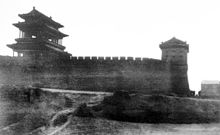Guang'anmen
Guang'anmen, also known as the Gate of Expansive Peace, Guangningmen and Zhangyimen, was a city gate of old Beijing, constructed during the reign of the Jiajing Emperor (1521–1567) of the Ming Dynasty. This gate was part of Beijing's city wall, situated south-west of the city center and facing east. Guang'anmen served as a main entrance to Beijing.
This article relies largely or entirely on a single source. (August 2012) |

